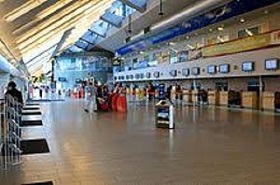Airport, Estonia, Good for Business, Tourism, Transport
International Internet Magazine. Baltic States news & analytics
Monday, 05.01.2026, 04:02
Tallinn Airport planning large terminal expansion by 2035
 Print version
Print version |
|---|
"In the last five years, we have grown practically by 50 percent or 1 million passengers. In total, we had 3 million passengers by the end of 2018. Growth has been big and bigger than we initially planned, but we have realized our growth potential very well," Tallinn Airport management board member and CFO Anneli Turkin said at a press conference on Wednesday. However, the current passenger terminal has been built for 2.6 mln passengers.
Turkin highlighted that Tallinn Airport is planning to grow two more times by 2030, if this is realized, the airport will reach 5 mln passengers. "This has been calculated purely based on how great the potential of the Estonian economy is, if we add to this the potential of aviation, it may exceed 5 million," she said.
The plan from there onward is even greater as, by 2035, the airport wants to create the potential for servicing up to 8 mln passengers, although the real number of passengers will likely reach 6 mln by that time.
"If we wish to continue as the best airport in Europe, we must, along with all other comforts and services, also ensure a good passenger capacity, which will ensure the timely departure of flights," Piret Murk-Dubout, outgoing CEO of Tallinn Airport who is to leave the post on Friday, said. She emphasized that infrastructure must be not an obstacle for the increase in the volumes of the airport.
According to the airport's plan, an expanded Tallinn Airport passenger terminal would enable to service 6-8 million passengers a year in 2035. The area of the terminal will be bigger by nearly three times, amounting to 85,000 square meters instead of the current 34,000 square meters. The number of passenger gates will grow by half, that is from 13 to 26.
"Already this year we will start designing and expanding the most critical hubs -- among them, for example, border control, luggage handling and the expansion of additional pre-waiting areas. Also the expansion of the pre-flight security area and the launch of an automatic border control in cooperation with the Police and Border Guard Board," Einari Bambus, member of the management board of the airport, said.
Turkin said that the airport is planning to finance the first steps, that is the expansions of border areas and the expansion of the luggage area, from own funds. Furthermore, the airport is planning to involve additional loan facilities by 2021. "If we speak about the complete solution, then we are still developing that business model," she said, adding that everything depends on what the productivity of the commercial premises is and how many commercial premises there will be in the expansion.
At the press conference, Bambus said that the design of the first stage of the passenger terminal expansion is already underway and the airport wishes to complete that by 2020 and then start building more vigorously already as well -- the planning and construction of the first stage should take place in 2020-2022, then the capacity will reach up to 4.2 mln passengers per year.
"That should be enough for some time but by 2025, the volume could already be such where there may be a need for 6 million. Our longer vision is 8 million, which we could service in the location we are at," Bambus said. As the next stage, the airport is planning to raise the capacity by 2025 to 6 million passengers after the construction of the second stage.
The last step, that is the planning and construction of the third stage, has been planned for the period 2028-2035 and then, the capacity should increase to 8 mln passengers. In the first stage, the area of the terminal is to grow to 45,000 square meters, by 2020, it should increase to 58,000 square meters. There should be 16 gates by 2022 and 21 gates already by 2024.
While the airport is currently servicing 17 aircraft during rush hour, then the number could already be 23 by 2022 and 31 by 2024.
There is no need for a new runway. "We no longer have a problem on the air traffic side, 8 mln passengers can be serviced with one runway as well," Murk-Dubout told. Bambus also noted that there is no need to expand nor extend the current runway as it is able to service essentially all aircraft types.
The increase in the number of air passengers also has a direct impact on the economy. "The impact of 3 mln passengers on the economy is approximately 2.6% of GDP a year. This means that the entire Estonian economy will benefit from the increase in passenger numbers," Turkin said.
The airport's plan also includes building up to 150,000 square meters of commercial, service and accommodation premises mainly meant for servicing air passengers to the airport's campus by 2035. The entire campus will develop into a significant added value for the airport as well as Tallinn and the whole of Estonia that will promote business and conference tourism and enable to earn additional income.
The construction work has been planned to take place in stages according to business environment opportunities and passenger number forecasts. In the next few months, Tallinn Airport is to submit an application to the city of Tallinn for the initiation of a detailed plan.








 «The Baltic Course» Is Sold and Stays in Business!
«The Baltic Course» Is Sold and Stays in Business!

